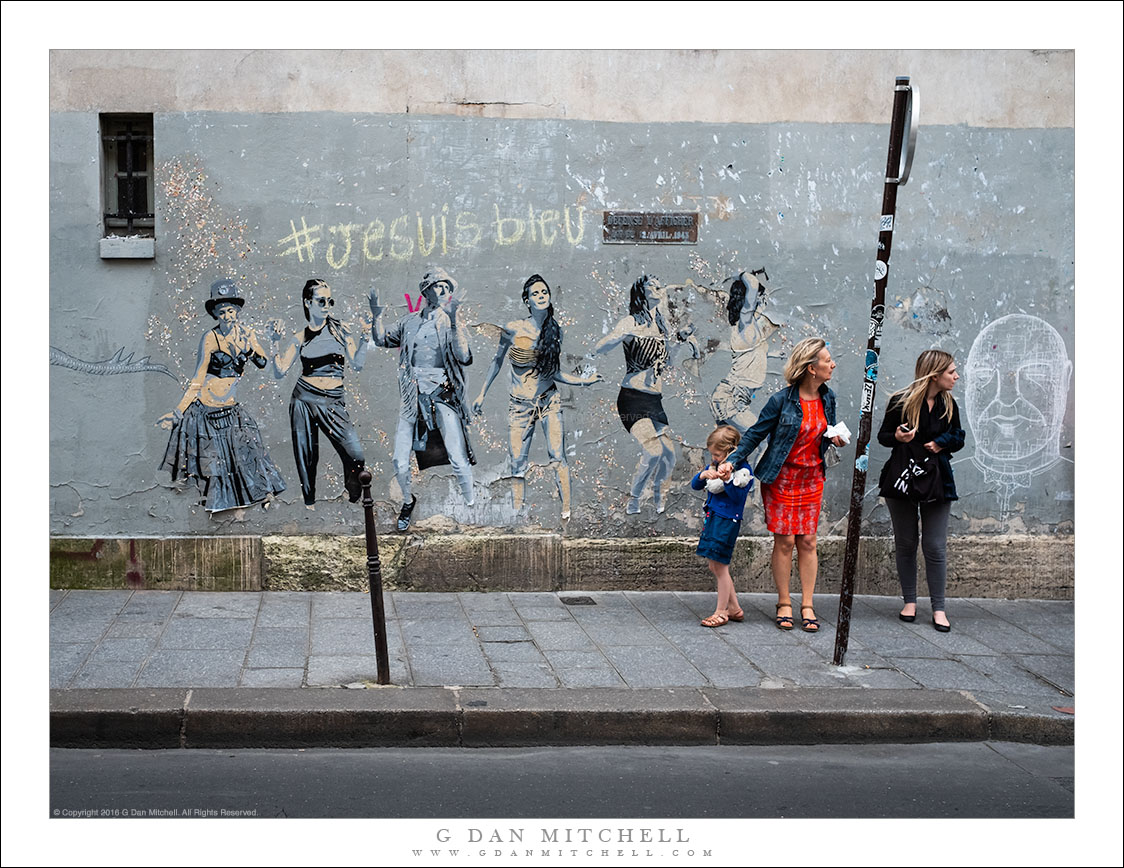
je suis bleu. Paris, France. August 10, 2016.
© Copyright 2016 G Dan Mitchell.
(“A Photograph Exposed” is a series exploring some of my photographs in greater detail.)
Much of my photography is in landscape and nature genres, but my work also includes other genres. For example, I am very enthusiastic about street and travel photography. I am going to use this photograph to explore that aspect of my photography and to share some background about this image and how it came about.
I made the photograph during a visit to Paris a few years ago, on a day when we spent time in Le Marais. There’s a lot going on in this popular part of Paris. There’s plenty of tourist stuff nearby — the Cathedral of Notre Dame is just a few blocks away and the Latin Quarter not far beyond. But walking in the opposite direction takes you into an older area of Paris, with narrow, twisting streets, old buildings, and a lot of character.
We explored without relying on written or human guides, preferring to wander and discover. Photography was on my mind, and I made several other photographs in this area where the light is often lovely, the streets are narrow, and the buildings and people fascinating.
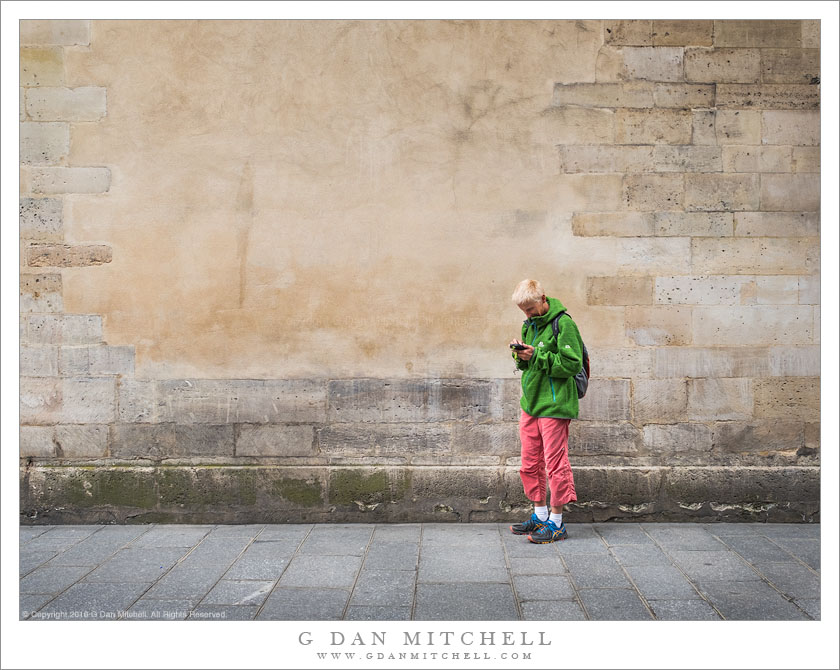
Woman, Wall, Le Marais
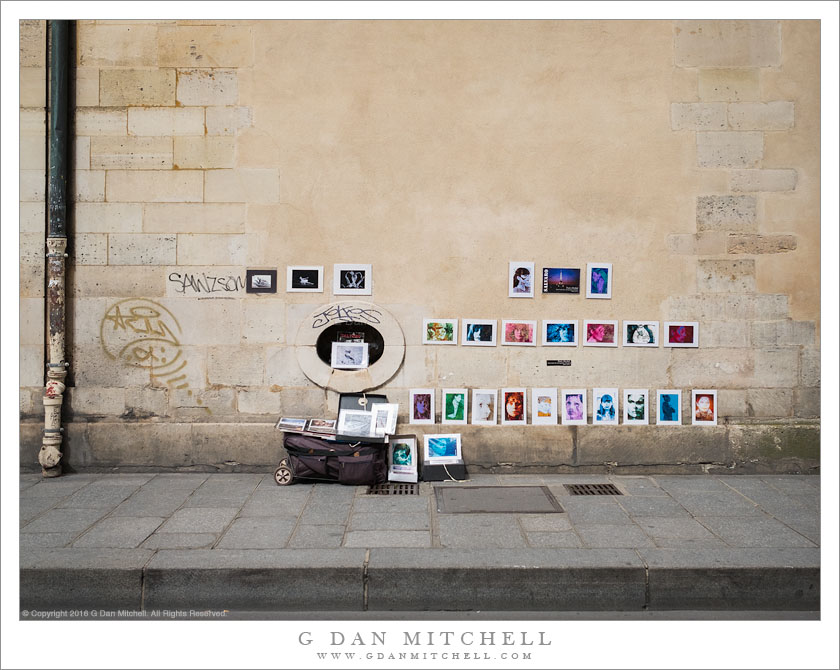
Sidewalk Art, Le Marais
Street photography
A lot of street photography is done quickly and spontaneously, and I always work with a small, handheld camera, usually with a small prime lens. There are many reasons for this camera/lens choice, but one is that this gear doesn’t read as ‘tourist with big camera.” People mostly ignore me in the street, and when they do see the little camera they often seem not to think that I’m a “serious photographer.”
My goal is to photograph what is happening in the street, and I don’t want my presence with the camera to affect that any more than necessary. I watch and wait. When I see something I often make a photograph quickly and without a lot of fuss and then move on.
Before long we came to the fascinating bit of street art that you see on the wall in the “je suit bleu” photograph at the top of this page. These figures were glued to walls elsewhere in Le Marais and Paris, and I later saw them in other locations in Europe. They are connected to a project called “Its Time To Dance” by SOBR. (Unfortunately, the SOBR website appears to be defunct.) In fact, I photographed one of the very same figures on a graffiti-covered wall in Berlin.
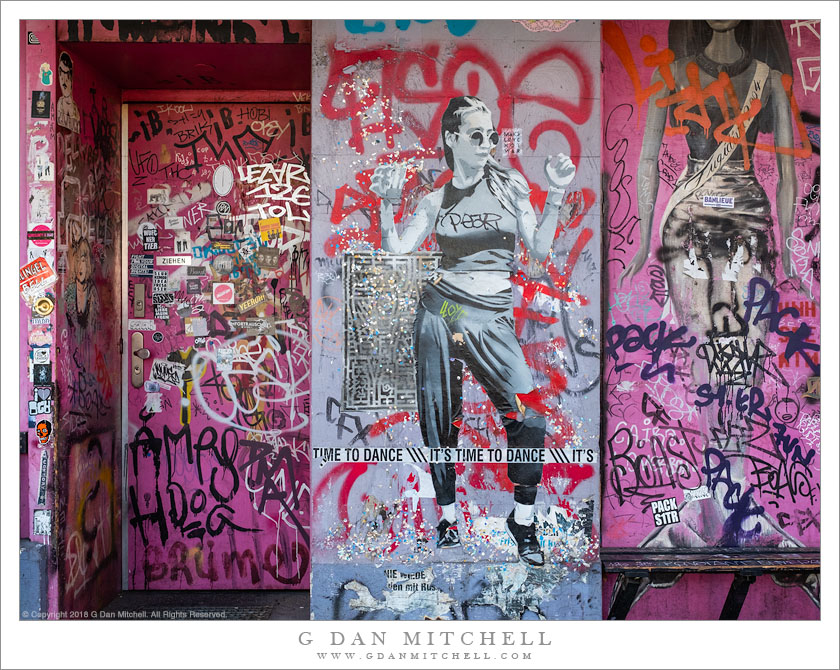
“Time to Dance”
So the line of a half-dozen of the dancing figures on the wall caught my eye, as did the surrounding layers of markings: the large chalk head at the far right, the #jesuisbleu hashtag (whose exact meaning in this context I still don’t fully understand), a spray of tiny paper tags glued to the wall, the weathered quality of the old and repainted wall, the black bollard, the pole holding the sign, and more. I made a quick photograph of the wall — one that I have not previously shared.
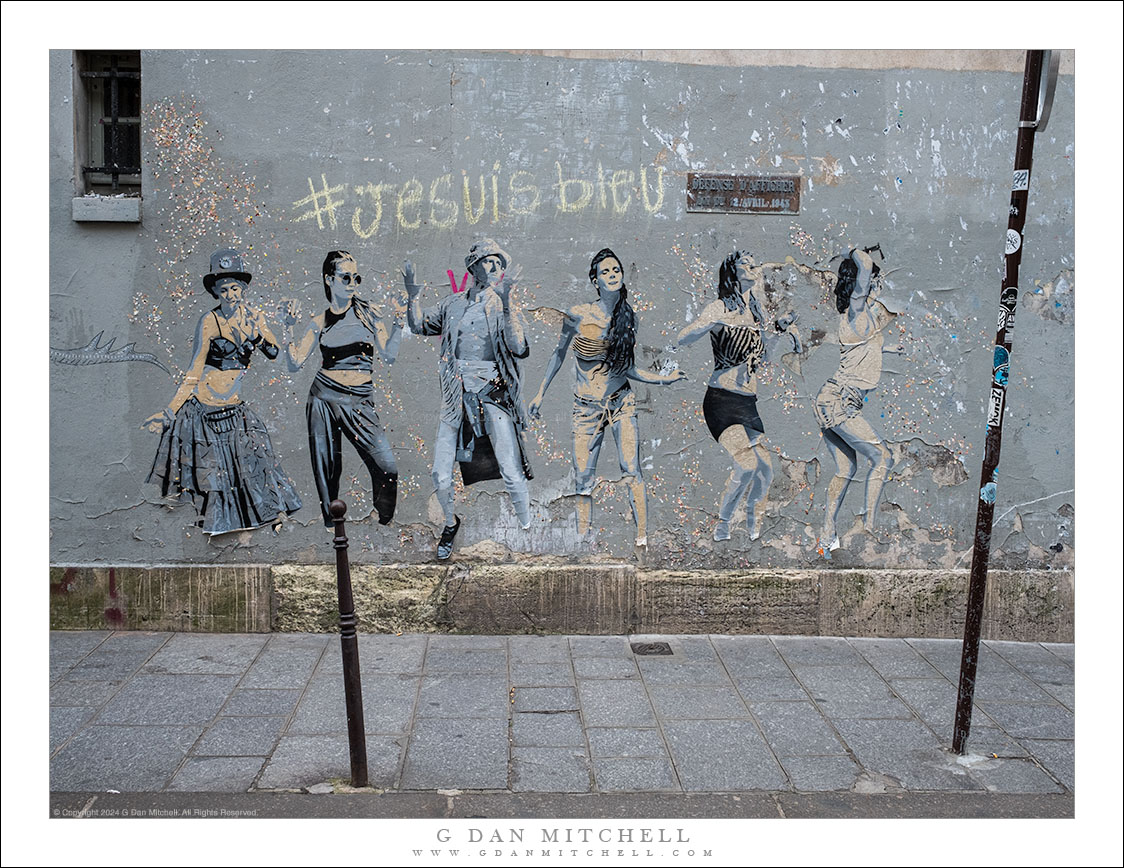
As fascinating as the wall was, I’m usually not moved (with a few exceptions) by photographs of other people’s art, so just making a straight-on photograph of the wall itself wasn’t very satisfying.
Populating the scene
I have a strategy in these situations. I begin by thinking more like a landscape photographer than a street photographer: I work out a “street landscape” composition that I think “works” visually. Here I decided on a straight on approach from the opposite side of the narrow street that could level the horizontal lines of the sidewalk and street and the upper edge of the painted section of the wall. In the final version I anchored the left side with the dark window, and I included the large chalk head on the right.
Then I waited. Typically someone interesting will eventually populate the scene, most often walking past in profile. Most passers-by won’t really “make the photo,” but it only takes one interesting or unusual person to tie things together. In Paris this turns out to be a bit of an interesting experience, as not everyone wants to be photographed. A few would telegraph that by stopping just out of frame when they saw me with a raised camera. I understood, smiled, put the camera down, and waved them through.
But I was almost certain that eventually someone interesting would pass through the frame and provide a visual focus. To be sure, a walking person in profile “has been done.” A lot. It isn’t always the most compelling way to photograph a person. But sometimes you work with what you have. My plan, as you might imagine, was to make the exposure as someone passed in front of me and entered the area between the two black poles. I actually made a few other photographs including people before and after I made the one that is the subject of this article.
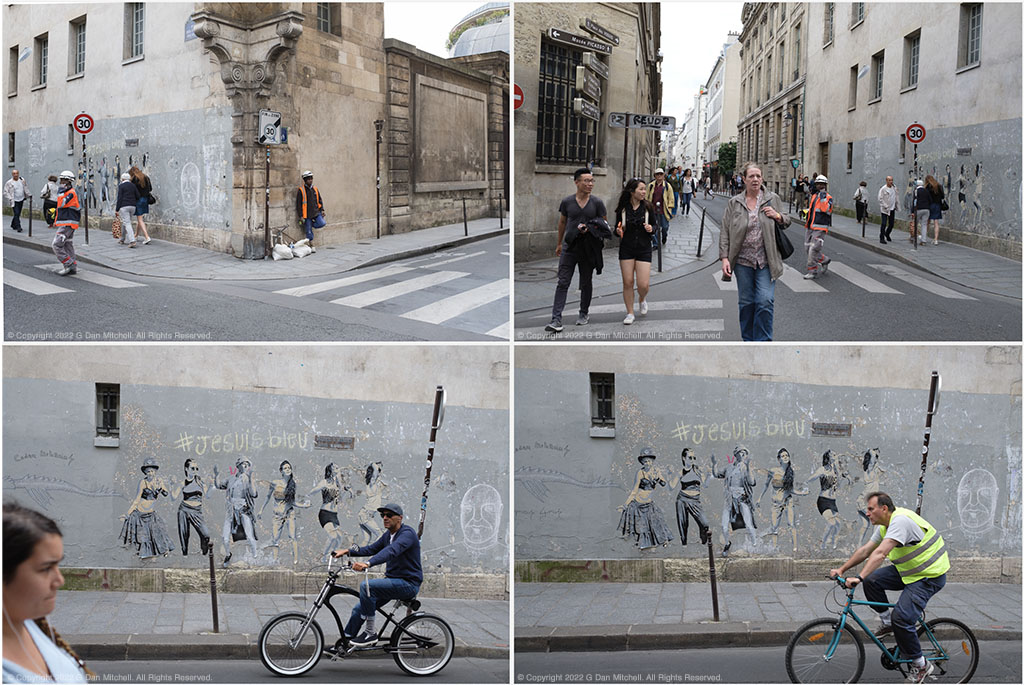
These photographs aren’t without interest, though they don’t do what the photograph in this article does. (On the other hand, since I started writing this article I reconsidered the two photograph on the left… and I’m seeing some possibilities hat I initially missed, for example see this and this.)
Before long I spotted the group of three women approaching the composition from my right. As per my plan, I watched for them to enter the frame so that I could make a photograph as they walked through that space between the two poles. (As you continue reading you may wish to open the photograph in a separate tab for easy access.)
Sometimes luck is on your side
At this moment the Photography Gods intervened as the trio entered the frame. Somewhere behind them (to my right) there was a very loud noise in the street. I no longer recall what it was — it could have been a shout, a bang, or something else.
They stopped. They wheeled around to see what had happened, though the little girl with the stuffed animal apparently wanted to keep going. Now instead of three people passing through the frame in profile, I had people twisting toward me, in dynamic off-kilter positions of tension, focused intensely outside the frame to the right.
But the Photography Gods weren’t done with me. These weren’t just three people on the street — they were three women, paused in front of street art featuring stylized images of women, perhaps suggesting a few things to read into the photograph. In addition, the three appear to be related and perhaps of two or three generations. (Grandmother, daughter, and granddaughter? Mother and two daughters of different ages?)
Think about the miracle of where they ended up positioning themselves. The three of them are grouped precisely on either side of the taller black pole, but no one intersects with the line of the pole! The woman on the right manages to avoid touching the outlines of the chalk face. On top of that, no one fully blocks any of the dancing figures on the wall.
The pose of the young girl on the left fascinates me. She holds her stuffed animal closely and up high, and her head is down. She appears to resist the twisting motion of the woman in the middle, and it looks like she continues to pull into the scene from right to left, perhaps straining against the woman holding her hand.
To quote those TV advertisements, “But wait, there’s more!”
Two of the three women are dressed in dark clothing that aligns with the cool tones of the light and colors in the scene, itself a bit of good fortune. (Imagine them wearing cartoon character t-shirts or fluorescent pink or funny hats.) Standing between them, the older woman is wearing… a red dress! Again, thank you Photography Gods!
If I had been given the opportunity to select and dress the characters and pose this photograph, I don’t think I could have come up with anything better. In truth, I don’t think I could have invented anything this good.
But, of course, I did not have time to think about much of this as I made the photograph. It all happened very quickly, I had an instant to take advantage of what happened, and I’m certain that I made the photograph based more on instinct and intuition than on conscious thought. How quickly did this all happen? I had time for only two exposures. In the second the three of them are already walking out of the frame.
As they left the frame, I recall looking at my wife (who is also a photographer) and muttering something along the lines of, “If I actually got what I think I just got, that’s going to be a good one!”
How Does This Happen?
I am fascinated by the roles of thoughtful choices, good preparation, careful observation, intuition, and plain dumb luck in photography. While their relative importance varies from photograph to photograph, it is a rare to get a successful photograph without all of them being at least minimally present.
I think there are lessons in this photograph and the circumstances of its creation. They are not unique to this photograph or even this genre. They cover a lot of ground, from practical to aesthetic. Here are a few of them, though by no means all.
Preparation and planning help. It may seem obvious, but at the most basic level you won’t have an opportunity to make certain kinds of photographs if you don’t put yourself in the right places at the right times. I wanted to make interesting street photographs, so I looked for an “urban landscape” where that was likely.
Attention and awareness are critical. Often the difference between an OK photograph and a good one may come down to fleeting and subtle things — a slight change in the light, a particular subject coming into view, the potential for interesting juxtapositions, the possibility (certainly not always the certainty) that something good may happen. In this case, the thing that first caught my attention (the street art) didn’t seem worthy of a serious photograph, so I started paying attention to what else might happen against that background.
Intuition makes a difference. While I took a moment to frame the scene around the street art, I didn’t have a lot of time to think about this. Rather than spending too much time objectively analyzing the scene and its components, I usually have to work quickly and intuitively. In many case, I “just know” when I look at a scene how I’ll use it. Later on I may be able to analyze and explain in retrospect how the photograph works, but in the moment I usually do not think that way. (To think too much risks missing a shot.)
Experience helps. Since I have made a lot of street photographs I quickly had some ideas about how to work with this scene. As described, my first thought was to use the technique of waiting for someone interesting to enter the scene. In addition, the intuition I wrote about in the previous paragraph is focused by having many previous experiences with related subjects. This extends to many other aspects of making the photograph — the ability to operate the camera quickly, being able to quickly make sense of the scene, knowing how to interact with passers-by, and so forth.
Failure is expected. I do not know of any photographer who makes only successful photographs, much less only makes great photographs. Particularly with the dynamic subjects common in street photography (but this applies to virtually every other kind of photography, too) not everything is going to “work.” The failures are usually part of the process that leads to the successes. Don’t lament them. Learn from them, let them go, but don’t focus on them. (I always remember the Ansel Adams comment that a dozen really good photographs per year is a good crop.) The process leading to this photograph produced more failures than successes — but one success is enough!
Be ready even when the prospects are not promising. As you can see from the other photographs I made right before the one that is the subject of this article, things were not really looking all the promising. At this spot I got a couple of pictures of out-of-focus bicyclists, a wall, a guy leaning against the wall, some people walking in the street. I went ahead and photographed those things. For one thing, making pictures keeps me on my toes. For another, subjects often are only in their ideal state for a brief instant. Often with street photography I photograph what I hope will happen. If you wait until it actually happens, you may be too late.
Plan, but hope for miracles and capitalize on luck. We rarely have anything approaching full control over the elements of such scenes. Even in landscape photography, where the subject may be virtually static, the light changes and can make all the difference. (I have landscape photographs that work due to an instant of astounding light that was as unexpected and fleeting as the woman in the red dress.) Be ready! Go ahead and make an exposure even if you aren’t sure it will work. If you wait to make sure everything looks perfect you may be too late or you may not make the exposure at all! And when/if you a given a visual gift like the one I got on this street, take it!
The Meaning of the Photograph
People look at this photograph and sometimes want to know what it means or how to interpret it. These are valid things to wonder about, and it is almost always worthwhile to consider what a photograph might say beyond its objective visual appearance. (This is one reason why I love Minor White’s famous comment: “One does not photograph something simply for ‘what it is’, but ‘for what else it is.”)
That being said, I almost never am thinking about a particular meaning or message when I make a photograph. I generally respond to subjects and scenes without a lot of conscious thought about implications of the visual content.Yes, there are occasional exceptions, but this photograph is not one of them. At the moment I made it, my focus was on the decisions I had already made about the location and overall subject and on timing the capture of the instant as it occurred. There really wasn’t any time left over to think consciously about meaning.
However, that may not be the end of the story. Someone once pointed out that a difference between painters and photographers is that painters, in a sense, know every inch of the painting since they created all of the content themselves(I know, this point could be debated) while photographers virtually never do. This means that we often discover things about a photograph after we make it, sometimes a long time later. A photograph may turn out to evoke unplanned associations or ideas that were only subliminally present at the time you made it. Perhaps there is a “what else” for you to find in this photograph.
Why does a landscape photographer shoot street?
This is one of my favorite questions, and I think I’ll end with it. I am pretty sure that most people who know my photography don’t think of me primarily (if at all) as a street photographer — the more typical description is “landscape photographer” or “nature photographer.” So, what’s up with this other stuff?
Perhaps my musical background helps explain why I don’t constrain myself to one genre of photography. In another life I was a professional trombone player. I played all kinds of music, from symphony orchestras to Broadway musicals, avant garde and experimental music, jazz and rock… and eventually music created using electronic and computer tools. In music it is common to explore a wide range of styles and types of music, and the idea of limiting oneself to one narrow vector — say early 18th century harpsichord music — is unusual. (And those who do have such narrow focus often venture beyond it, too.)
I feel the same way about photography. There’s no reason that photographing landscapes should mean that you don’t photograph people or cities or birds or whatever. I think photography is about “photographic seeing” more than about any particular subject.
In fact, I think there are distinct advantages to exploring more than one photographic genre. Photographing bicycle races a couple of decades ago made me a better photographer of birds in flight. The street, where there are almost too many subjects to photograph and everything is in motion, taught me to think and compose quickly and intuitively. Landscape photography perhaps makes me more attentive to the city as an urban landscape. My background doing long exposure night photography in industrial settings led me to do night street photography.
As Muir once noted, diverse things often end up being connected:
“When we try to pick out anything by itself, we find it hitched to everything else in the Universe.“ — John Muir
The Photograph Exposed series:
- A Photograph Exposed: “Submerged Boulders, Lake, and Cliffs” (2010)
- A Photograph Exposed: A Tale of Light (2011)
- A Photograph Exposed: Photography and Luck (2012)
- A Photograph Exposed: “San Francisco Skyline — Winter Fog and Haze” (2015)
- A Photograph Exposed: “Two Rocks, Morning, Racetrack Playa” (2015)
- A Photograph Exposed: “Two Islands, Fog” (2015)
- A Photograph Exposed: “Shoreline Reflections, Trees and Rocks” (2015)
- A Photograph Exposed: One Subject, Two Compositions (2015)
- A Photograph Exposed: Technique and Interpretation in Post (2015)
- A Photograph Exposed: Je Suis Bleu (2022)
G Dan Mitchell is a California photographer and visual opportunist. His book, “California’s Fall Color: A Photographer’s Guide to Autumn in the Sierra” is available from Heyday Books, Amazon, and directly from G Dan Mitchell.
Blog | About | Flickr | Facebook | Email
Links to Articles, Sales and Licensing, my Sierra Nevada Fall Color book, Contact Information.
Scroll down to leave a comment or question. (Click this post’s title first if you are viewing on the home page.)
All media © Copyright G Dan Mitchell and others as indicated. Any use requires advance permission from G Dan Mitchell.
Discover more from G Dan Mitchell Photography
Subscribe to get the latest posts sent to your email.
